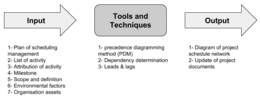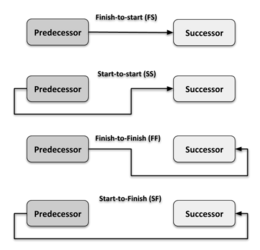Dependency in project management
(→Tools and methods used in sequence activities) |
|||
| Line 39: | Line 39: | ||
==Tools and methods used in sequence activities== | ==Tools and methods used in sequence activities== | ||
| + | |||
| + | *'''1. Precedence diagramming Method (PDM)''' | ||
| + | The PDM is a common visual tool to draw a diagram of project schedule network, which depicts graphical rectangles, known as nodes, connected by one or more logical relationships to represent activities in these boxes. A precedence diagram is shown with the aid of activity-on-node (AON) strategy that is applied frequently within project management software. There are four logical relationships or dependencies in the package of PDM, including finish-to-start (FS), finish-to-finish (FF), start-to-start (SS), and start-to-finish (SF), containing a predecessor activity depicted logically prior to a dependent activity of a schedule, and a successor activity as a dependent activity depicted logically after another activity of a schedule. | ||
| + | |||
| + | *In a logical relationship of FS, a successor activity can be advanced when the predecessor activity has finished; for instance, the ceremony of awards (the successor activity) can be advanced when the competition (the predecessor activity) has elapsed. | ||
| + | *In a logical relationship of FF, a successor activity can finish when a predecessor activity has finished; for instance, a document editing (the successor activity) can end when a document writing (the predecessor activity) has finished. | ||
| + | *In a logical relationship of SS, a successor activity can be advanced when a predecessor activity has advanced; for instance, Level concrete (the successor activity) can be advanced when a pour foundation (the predecessor activity) has advanced. | ||
| + | *In a logical relationship of SF, a successor activity can be ended when a predecessor activity begins; for instance, the first shift of security guard (the successor activity) can be ended when the second shift of security guard (the predecessor activity) begins. | ||
| + | The most and the least commonly used logical relationships in the PDM are FS and SF, respectively. However, all of these logical relationships are present in a complete list of the PDM. | ||
== The precedence diagramming method (PDM) == | == The precedence diagramming method (PDM) == | ||
Revision as of 15:58, 2 March 2019
Developed by Behzad Sanie
Contents |
Abstract
Dependency in project management means that one activity is depended to another.[1] The purpose of dependency determination is indicating the type of dependency that makes a logical relationships between predecessor and successor activities. Four types of dependency defined as: Finish-to-start (FS), Finish-to-finish (FF), Start-to-start (SS), Start-to-finish (SF).[2] The precedence diagramming method (PDM), as an example of the application of dependency, includes the four types of independencies or logical relationships.
Introduction
In project time managing, defining the sequence of the activities is necessary for documenting and recognising the relationship between each activities. The point is defining a logical sequence between tasks to do and increase efficiency during the project limitations. The sequence activity process includes inputs, tools and techniques, and output.[3] The input will be plan of scheduling management, list of activity, attribution of activity, milestone, scope and definition, environmental factors and organisation assets. The application tools and techniques are precedence diagramming method (PDM), dependency determination and leads & lags. The expected outputs are diagram of project schedule network and update of project documents.[3]
Sequence Activities
The relationships between the activities of a project can be detected and documented in a process known as Sequence Activities, which are capable of considering the rational sequence of work and all project limitations to achieve the highest efficiency. Minimum a predecessor having a logical relationship of finish-to-start or start-to-start as well as minimum a successor having a logical relationship of finish-to-start or finish-to- finish are required to link every activity and milestone, except for the first and last ones. A realistic and achievable project schedule should be considered in the design of logical relationships, which might be essentially supported using lead or lag time between the activities. In this context, project management software or manual or automated approaches can be beneficial in sequencing.
Inputs required in sequence activities
- 1. Schedule Management Plan (SMP): The SMP is a pre-project preventive thinking to identify several points, including the scheduling process involved in the project, thus helping the sequence activities.
- 2. Activity List : The activity list contains a critical pathway and basically a detailed documentation of all schedule activities required and sequenced for a particular project. The sequence activities can be affected by the dependencies and limitations that exist on the path to these activities.
- 3. Activity Attributes : Activity attributes generally refers to active components associated with an activity, which may be pivotal for sequencing for details like events, predecessors or successor.
- 4. Milestone List : The milestone list as a project management document may schedule all specific project milestones influencing sequence activities.
- 5. Project Scope Statement: The project scope statement is a good means to describe the key deliverables of a project, including product properties involved in sequence activities like physical lineament of a project being implemented or the nature of a software project. Other scope statements of project can detail constraints and assumptions associated with sequence activities. Although, these are mostly recorded in the activity list, their accuracy is explored as product scope description.
- 6. Enterprise Environmental Factors: The success of sequence activities can be depended on either internal or external enterprise environmental factors (EEFs), including government regulations, industry conditions, project management information system (PMIS), scheduling tool, or work authorisation system (WAS).
- 7. Organizational Process Assets : Another factor contributing to the sequence activities is the organizational process assets (OPAs), including project plans of the corporate, formal or informal policies, procedures, processes, scheduling methods to developing logical relationships, and templates required for providing networks of project activities. Sequence activities can benefit from additional descriptive data provided by information related to activity characteristics in templates.
Tools and methods used in sequence activities
- 1. Precedence diagramming Method (PDM)
The PDM is a common visual tool to draw a diagram of project schedule network, which depicts graphical rectangles, known as nodes, connected by one or more logical relationships to represent activities in these boxes. A precedence diagram is shown with the aid of activity-on-node (AON) strategy that is applied frequently within project management software. There are four logical relationships or dependencies in the package of PDM, including finish-to-start (FS), finish-to-finish (FF), start-to-start (SS), and start-to-finish (SF), containing a predecessor activity depicted logically prior to a dependent activity of a schedule, and a successor activity as a dependent activity depicted logically after another activity of a schedule.
- In a logical relationship of FS, a successor activity can be advanced when the predecessor activity has finished; for instance, the ceremony of awards (the successor activity) can be advanced when the competition (the predecessor activity) has elapsed.
- In a logical relationship of FF, a successor activity can finish when a predecessor activity has finished; for instance, a document editing (the successor activity) can end when a document writing (the predecessor activity) has finished.
- In a logical relationship of SS, a successor activity can be advanced when a predecessor activity has advanced; for instance, Level concrete (the successor activity) can be advanced when a pour foundation (the predecessor activity) has advanced.
- In a logical relationship of SF, a successor activity can be ended when a predecessor activity begins; for instance, the first shift of security guard (the successor activity) can be ended when the second shift of security guard (the predecessor activity) begins.
The most and the least commonly used logical relationships in the PDM are FS and SF, respectively. However, all of these logical relationships are present in a complete list of the PDM.
The precedence diagramming method (PDM)
PDM is a tool for programming activities in planning a project. It is a method of constructing a network diagram of the project schedule that uses boxes, called nodes, to represent the activities and connects them with arrows that show the dependencies. PDM, In a network technology project, focuses on the precedence of activities and logical relationships. It is also known as the activity-on-node or AON and used by many project management software packages.
Types of dependencies
Four types of dependencies or logical relationship are linking predecessor activity and successor activity together in PDM. Predecessor activity comes before successor activity which is logically a depended activity in a schedule planning. Example: collecting data in a software project management is a predecessor activity and analysing the data is a successor activity. An activity must be time bound with a start and end time. This time bounding acquires the four types of dependencies between predecessor and successor which defined below:
- Finish-to-start (FS): A successor activity can start when a predecessor activity has finished. Example: building the walls (successor) in a house cannot start before finish the foundation (predecessor).
- Finish-to-finish (FF): A successor activity can finish when a predecessor activity has finished. Example: Wall construction (predecessor) is required to finish before electrical wiring (successor) inside the walls can finish.
- Start-to-start (SS): A successor activity cannot start if a predecessor activity has not begun. Example:
- Start-to-finish (SF): A successor activity cannot finish if a predecessor activity has not begun. Example:
Dependency determination
Dependencies identify by the following attributes:
- Mandatory dependencies
- Discretionary dependencies
- Internal dependencies
- External dependencies
Annotated Bibliography
Reference
- ↑ GRANDE-BRETAGNE. (2017). Managing successful projects with PRINCE2.
- ↑ Project Management Institute. (2013). A guide to the project management body of knowledge (PMBOK® Guide). 5th ed. Pennsylvania: Project Management Institute, pp. 156-159.
- ↑ 3.0 3.1 Project Management Institute. (2013). A guide to the project management body of knowledge (PMBOK® Guide). 5th ed. Pennsylvania: Project Management Institute, pp. 153.

